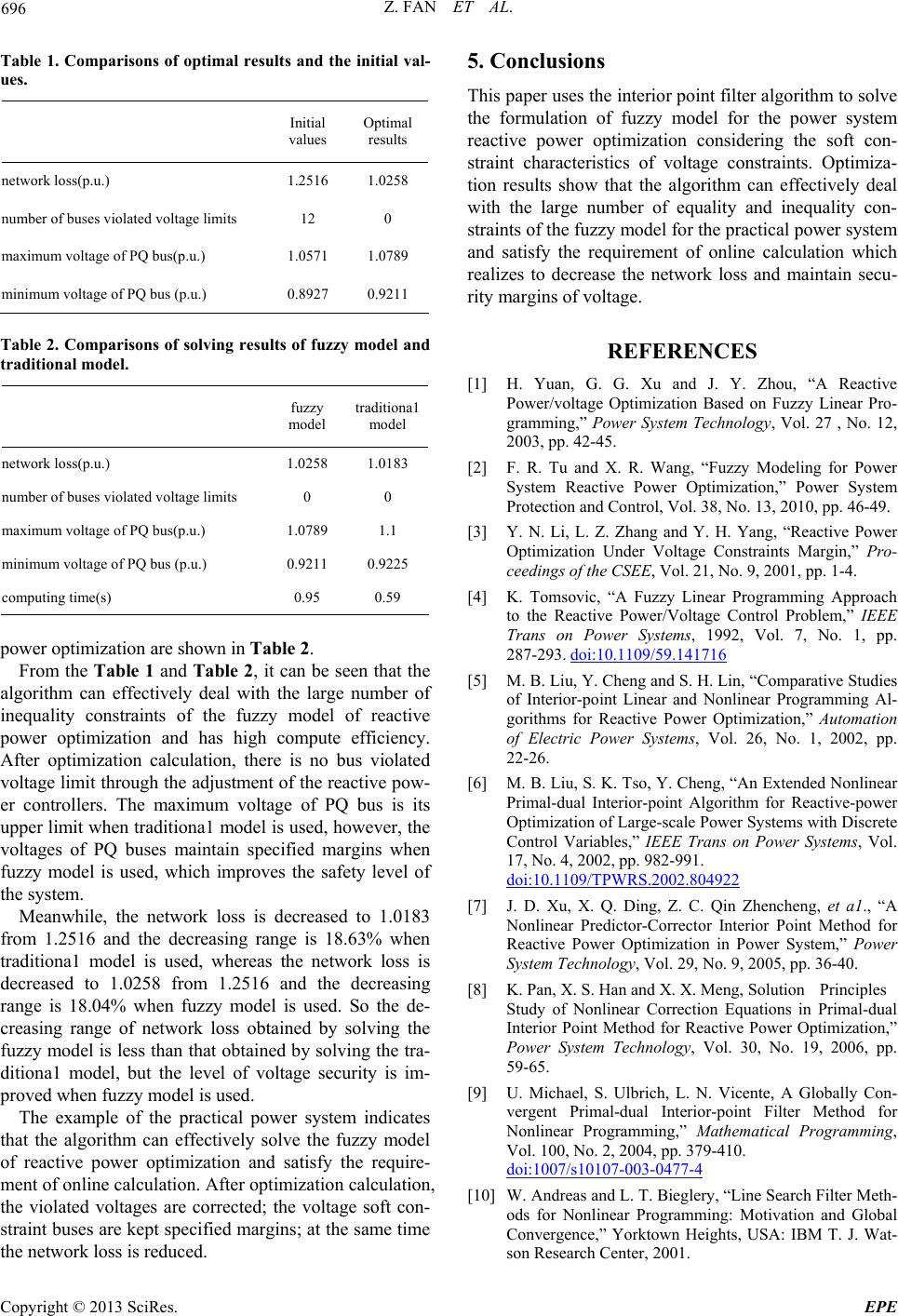
Z. FAN ET AL.
696
Table 1. Comparisons of optimal results and the initial val-
ues.
Initial
values Optimal
results
network loss(p.u.) 1.2516 1.0258
number of buses violated voltage limits 12 0
maximum voltage of PQ bus(p.u.) 1.0571 1.0789
minimum voltage of PQ bus (p.u.) 0.8927 0.9211
Table 2. Comparisons of solving results of fuzzy model and
traditional model.
fuzzy
model traditiona1
model
network loss(p.u.) 1.0258 1.0183
number of buses violated voltage limits 0 0
maximum voltage of PQ bus(p.u.) 1.0789 1.1
minimum voltage of PQ bus (p.u.) 0.9211 0.9225
computing time(s) 0.95 0.59
power optimization are shown in Table 2.
From the Table 1 and Table 2, it can be seen that the
algorithm can effectively deal with the large number of
inequality constraints of the fuzzy model of reactive
power optimization and has high compute efficiency.
After optimization calculation, there is no bus violated
voltage limit through the adjustment of the reactive pow-
er controllers. The maximum voltage of PQ bus is its
upper limit when traditiona1 model is used, however, the
voltages of PQ buses maintain specified margins when
fuzzy model is used, which improves the safety level of
the system.
Meanwhile, the network loss is decreased to 1.0183
from 1.2516 and the decreasing range is 18.63% when
traditiona1 model is used, whereas the network loss is
decreased to 1.0258 from 1.2516 and the decreasing
range is 18.04% when fuzzy model is used. So the de-
creasing range of network loss obtained by solving the
fuzzy model is less than that obtained by solving the tra-
ditiona1 model, but the level of voltage security is im-
proved when fuzzy model is used.
The example of the practical power system indicates
that the algorithm can effectively solve the fuzzy model
of reactive power optimization and satisfy the require-
ment of online calculation. After optimization calculation,
the violated voltages are corrected; the voltage soft con-
straint buses are kept specified margins; at the same time
the network loss is reduced.
5. Conclusions
This paper uses the interior point filter algorithm to solve
the formulation of fuzzy model for the power system
reactive power optimization considering the soft con-
straint characteristics of voltage constraints. Optimiza-
tion results show that the algorithm can effectively deal
with the large number of equality and inequality con-
straints of the fuzzy model for the practical power system
and satisfy the requirement of online calculation which
realizes to decrease the network loss and maintain secu-
rity margins of voltage.
REFERENCES
[1] H. Yuan, G. G. Xu and J. Y. Zhou, “A Reactive
Power/voltage Optimization Based on Fuzzy Linear Pro-
gramming,” Power System Technology, Vol. 27 , No. 12,
2003, pp. 42-45.
[2] F. R. Tu and X. R. Wang, “Fuzzy Modeling for Power
System Reactive Power Optimization,” Power System
Protection and Control, Vol. 38, No. 13, 2010, pp. 46-49.
[3] Y. N. Li, L. Z. Zhang and Y. H. Yang, “Reactive Power
Optimization Under Voltage Constraints Margin,” Pro-
ceedings of the CSEE, Vol. 21, No. 9, 2001, pp. 1-4.
[4] K. Tomsovic, “A Fuzzy Linear Programming Approach
to the Reactive Power/Voltage Control Problem,” IEEE
Trans on Power Systems, 1992, Vol. 7, No. 1, pp.
287-293. doi:10.1109/59.141716
[5] M. B. Liu, Y. Cheng and S. H. Lin, “Comparative Studies
of Interior-point Linear and Nonlinear Programming Al-
gorithms for Reactive Power Optimization,” Automation
of Electric Power Systems, Vol. 26, No. 1, 2002, pp.
22-26.
[6] M. B. Liu, S. K. Tso, Y. Cheng, “An Extended Nonlinear
Primal-dual Interior-point Algorithm for Reactive-power
Optimization of Large-scale Power Systems with Discrete
Control Variables,” IEEE Trans on Power Systems, Vol.
17, No. 4, 2002, pp. 982-991.
doi:10.1109/TPWRS.2002.804922
[7] J. D. Xu, X. Q. Ding, Z. C. Qin Zhencheng, et a1., “A
Nonlinear Predictor-Corrector Interior Point Method for
Reactive Power Optimization in Power System,” Power
System Technology, Vol. 29, No. 9, 2005, pp. 36-40.
[8] K. Pan, X. S. Han and X. X. Meng, Solution Principles
Study of Nonlinear Correction Equations in Primal-dual
Interior Point Method for Reactive Power Optimization,”
Power System Technology, Vol. 30, No. 19, 2006, pp.
59-65.
[9] U. Michael, S. Ulbrich, L. N. Vicente, A Globally Con-
vergent Primal-dual Interior-point Filter Method for
Nonlinear Programming,” Mathematical Programming,
Vol. 100, No. 2, 2004, pp. 379-410.
doi:1007/s10107-003-0477-4
[10] W. Andreas and L. T. Bieglery, “Line Search Filter Meth-
ods for Nonlinear Programming: Motivation and Global
Convergence,” Yorktown Heights, USA: IBM T. J. Wat-
son Research Center, 2001.
Copyright © 2013 SciRes. EPE